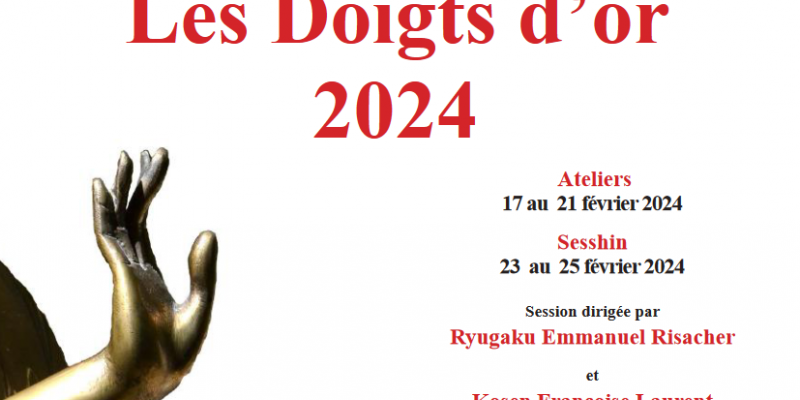
Les Doigts d'or" retreat - February 2024
Session led by Emmanuel Ryugaku Risacher and Françoise Kosen Laurent.
Download the programme in PDF format
Programme
WORKSHOPS ( Sumi-e, Kesa sewing, Shiatsu & Do-In, Ikebana, Tai chi chuan, Calligraphy, Yoga, Samu) - from 17 to 21 February 2024
Arrival Workshops: Friday afternoon 16 February. Dinner at 8.30pm.
7.00 am Zazen
9:30am-12:00pm Workshops
12.30pm Lunch
14h30-17h Workshops
6pm Zazen
7.30pm Lunch
Departure: For those attending the workshops only, on Thursday 22 February after breakfast.
For those staying on, rest day on 22 February.
Online registration for workshops.
SESSHIN (Zen meditation retreat) - 23 to 25 February 2024
Arrival for sesshin on Thursday 22 February in the afternoon, dinner at 8.30 pm.
The sesshin ends on Sunday 25 February after lunch.
Online registration for sesshin
Les Doigts d'Or
Golden Fingers Week is a unique opportunity to combine the practice of Zen with artistic expression, either by discovering a technique or by exploring it in greater depth. And, as the Buddha recommended, it's the ideal opportunity, in the context of La Gendronnière, to see and observe the attachments, fears and mental habits that stand in the way of our own creativity.
Learning to let the creative act take place in each moment, beyond the conditioned representations of the 'I' and its negative judgements, brings great joy and leads to inner tranquillity. Accept what comes, just as it is!
With a bit of paint, a brush, a needle and thread, with your hands, with your body, let your creative interiority express itself. It is neither the medium, nor the means, nor the result that matters, but the conscious actualisation of the original nature that animates the gesture, contains and fills the form.
Practising the Buddha Way
Zazen is objectless sitting meditation, as practised by the Buddha and handed down through the ages by an unbroken lineage of masters. It is meditation in the silence and nakedness of the present moment. It is a return to that which is 'before' thought is deployed in an attempt to grasp what simply is.
This happens effortlessly when attention simply returns to what is present. The time of meditation escapes time itself because it is a return to the still source of our existence. When the original source is seen, every breath, every action, every movement spontaneously becomes the luminous expression of life itself, and the duality between subject and object disappears.
During the five-day workshops, zazen will be practised in the morning and late afternoon.
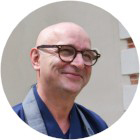 Emmanuel Ryugaku Risacher
Emmanuel Ryugaku Risacher
Emmanuel Risacher will be in charge of the Golden Fingers session, which he is organising with Françoise Kosen Laurent. He was ordained a bodhisattva in 1972 and a monk in 1980 by Master Deshimaru. In November 2008, he received Dharma transmission from Genshu Imamura Roshi. From 2016 to 2019 he was in charge of the Gendronnière temple.
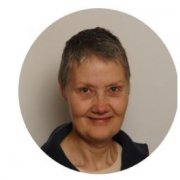 Kosen Françoise Laurent
Kosen Françoise Laurent
Françoise Kosen Laurent was ordained a nun in 1976 by Master Deshimaru and received transmission of the Kojun Kishigami roshi Dharma in 2018.
The workshops
Sewing the Kesa
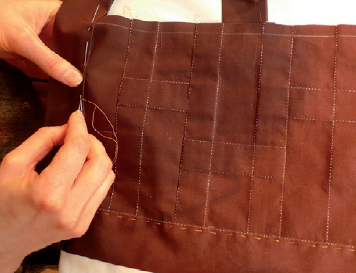
Sewing the kesa means making the Buddha's garment according to the method handed down from Shakyamuni. Abandoning any desire for decoration or personal innovation, we concentrate on each step and each stitch, with patience and determination. Unconsciously, naturally and automatically, this practice changes our mind. From our efforts comes the pure garment of Dharma and we realise the highest dimension of creativity. Master Kodo Sawaki used to say, "The kesa is the cloth that becomes Buddha."
Teachers: Patrick Rei Un Mor and Tina Chin Myo Feller have been practising and teaching kesa sewing for many years, in dojos and sesshins, and more particularly at La Gendronnière.
Sumi-e
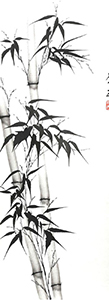
Sumi-e, a Chinese method of painting with Chinese ink, was introduced to Japan five centuries ago. "Sumi" means black ink, "e" means paint. The subjects are painted in ink, in shades ranging from pure black to all the gradations obtained by diluting with water. A simple brush, a strip of Indian ink, a stone and a sheet of rice paper are all you need to practise sumi-e.
This way of painting is total because it involves the whole body and is by no means easy. An instructor is essential. You also have to get used to repeating the chosen subjects or even details of the final composition many times. Everyone, whatever their level, whether interested in or curious about experimenting with this 'ancient' Oriental approach, will find a new and spontaneous path to artistic expression. Thanks to a relaxed posture and correct breathing, the coordination and fluidity of gestures improves. Painting a flower, a rock or a piece of bamboo becomes a total act emanating from the body itself, in the fullness of the present moment.
Sumi-e is not about learning a simple painting method. It is about direct contact with our essential being, Buddha nature, beyond 'doing' or 'not doing'. The life created by the touch of the brush reinforces Life itself. Contribution to workshop costs (brushes, ink, paper and rice paper): €25
The teacher : Beppe Mokuza Signoritti, a Zen monk and disciple of Roland Yuno Rech, has been practising sumi-e for some twenty years. He exhibits and gives lectures and practical demonstrations throughout Europe. www.sumi-e.fr
Ceramics
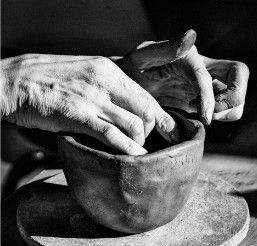
Working with what's under our feet and close at hand reconnects us with nature and with ourselves: the simplicity and spirit of the gesture. Using quarry clay and fuel, everyone, whatever their level, will be able to make their own pieces and practise firing techniques. Clay and its firings invite us to be present in our gestures, to rely on fire and to let ourselves be surprised by the unexpected. Bring jeans and closed-toe leather or canvas shoes for the firings. Workshop fee (clay, glazes, materials): 25 euros
High-temperature ceramist, Zen nun and lover of everything that comes out of the ground, including rocks, Cécile Bardenet lives in the Haute-Saône countryside, where she devotes her time to this craft and to the Zen way. She used to live at La Gendronnière and has been practising Zen ever since.
Calligraphy
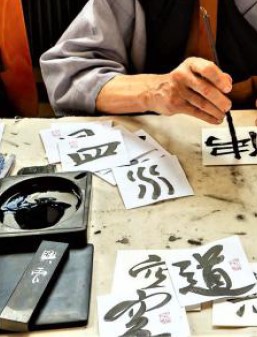
Calligraphy, that art of the line that reflects the state of mind and allows no repentance. There is only one path: concentration and tireless repetition, which unify the subject and the object in the deepest part of oneself, and thus become capable of making the work spring forth as naturally as a spring.
For beginners, this course will introduce you to the art of the brush, line drawing, the first kanji and, of course, posture and breathing. For the more experienced, it will be an opportunity to deepen their knowledge of kanji and composition. You're welcome to bring your own brushes,
ink and paper. For beginners, materials will be available or for sale on site.
Jacques Kugen Foussadier, a Zen monk and disciple of Master Deshimaru, was born in Paris on 8 December 1942. After seven years of study at the Beaux-Arts in Rouen and Paris, encouraged by his masters, he turned to the Orient. In 1969, he began a long apprenticeship in brush, ink and rice paper with master Ung-No Lee.
Taï chi chuan
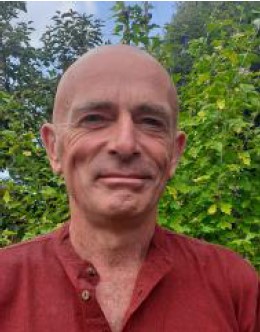
Slowness, lightness, gentleness: the three ingredients that make the practice of Tai chi a school of WELL-BEING, where gentleness, ease and harmony, combined with coordination, fluidity and grace, enable the practitioner to install in his or her body and mind an authentic and lasting serenity. Unlike intensive 'physical' practices that temporarily disguise a state of stress through fatigue, Tai chi chuan (meditation in movement) radically and sustainably transforms the inner being by unifying the opposites that tear us apart. Vital rhythms are rediscovered through slow, non-traumatic movements, giving you self-confidence and a sense of fulfilment.
Denis Clément has been practising zazen for thirty-five years. He has been teaching Tai Chi Chuan for thirty years as a qualified teacher with a BEESAPT (Brevet d'Etat d'éducateur sportif d'activité physique pour tous).
Ikebana
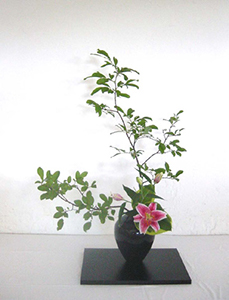
A traditional style of ikebana called kakubana can be used as a support for meditation, and thus the basis of a spiritual path. The kakubana style dates back to the end of the 17th century. It was codified under this name by Ippo Mishôsai (1761-1824), founder of the Mishô school. This style is typical of the school.
Kakubana is based on a Chinese cosmogonic principle represented by a diagram. This also forms the basis of the aesthetic. To compose a bouquet, you need to mentally imagine this diagram just above the vase.
Over the five days of the course, we'll develop this principle, learn how to apply it to your work and introduce you to the way of flowers. We will also look at modern ikebana.
Each participant should bring pruning shears and at least one flower pick. You will be asked to make a contribution towards the purchase of the flowers, but you will be able to take some of your bouquets home with you at the end of the course.
The teacher : Nobuko Matsumiya is an ikebana master, tea master, koto player, singer and founder and leader of a Japanese folk group, the Sakura Ensemble. Originally from Kyoto, the capital of traditional arts, she taught ikebana and tea privately before moving to France in 1987. She is a member of the Mishô School of ikebana (Mishô-Ryû), one of Japan's leading schools, and her master is Seiho Tachibana. She has been practising the Way of Flowers since 1970, and qualified as a teacher in 1973. In 1994, she was ordained as a bodhisattva under the name of Reigi, French for "spiritual attitude".
Shiatsu et Do-In
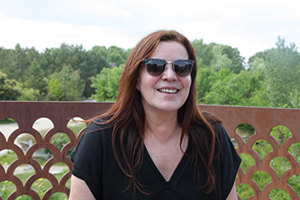
Shiatsu (finger pressure) is a manual technique of Japanese origin whose theoretical foundations are derived from traditional Chinese medicine.
By acting on all the meridians, shiatsu, by listening to the patient and his or her ailments, harmonises the circulation of Qi in the body by releasing tension or blockages. By rebalancing the body's main functions, it enables the body to regain its natural equilibrium. In Zen shiatsu, the right body/mind attitude is essential.
The workshop focuses on practical exercises, where you will learn the basic postures and gestures of shiatsu, which you can then pass on to others. It also includes do-in sessions (self-massage and gentle stretching), which have many beneficial effects, both in the practice of zazen and in everyday life.
Theoretical elements on Qi, Yin-Yang, Kyô and Jitsu (empty and full) and the meridians will be studied.
The teacher: Intimately linked to Japan and its traditions, Christine Marie Bottin has studied Japanese and worked on traditional arts, transmission, artistic and craft practices, and Buddhism. A disciple of Master Taisen Deshimaru, she began practising zazen in 1978 and was ordained a nun in 1981. Since 2009, she has been studying and practising shiatsu from the Iokaï school taught by K. Sasaki (a direct descendant of S. Masunaga).
Yoga
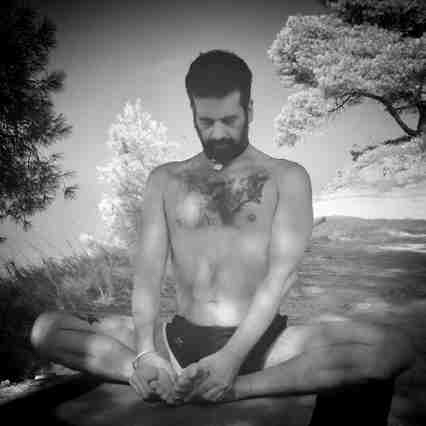
This workshop is specially designed for zazen practitioners: some asanas will prepare the body for (longer) periods of sitting and others will help it to relax and unwind after these periods. They will be seen as an aid to Dharma practice. We will learn to perform them in detail and with a sense of security, while reinforcing what needs to be reinforced to support the practice. We will focus on breathing and practise various exercises from the yoga tradition (pranayama) leading to a greater awareness of the full capacity of the lungs and their function. Each day there will be a time for oral sharing so that all the participants can express within the group what they need during the process, and thus support each other.
The teacher: Yorgos Fokiano has been practising hatha yoga for twenty years and has been teaching for fourteen years in Germany, Greece and many other countries around the world. He was trained by Cyndi Lee to lead yoga classes and workshops in New York and has followed renowned teachers in India, Germany and New York to deepen his knowledge of the art. Since 2011, he has been practising Soto Zen, which has changed his life and inluenced his yoga practice and teaching.
Samu
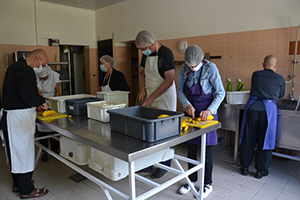
Samu, the generous action essential to the life of the community and the smooth running of the temple for the benefit of all.
For those who wish to donate their energy to the Sangha and the temple, this is an opportunity to participate in the organisation of the session (service, cleaning, etc.) as required.
Registration and rates

IMPORTANT
- Parental authorisation is required for minors.
- Compulsory AZI 2024 membership: €45 (€35 for low budget).
- Pets are not allowed.
REGISTRATION
- Online : workshops / sesshin only
- By post, by returning the enclosed registration form: leaflet
- Information : 02 54 44 04 86 or lagendronniere@zen-azi.org
Temple zen de la Gendronnière
41120 Valaire (près de Blois)
